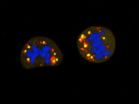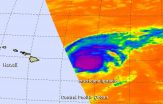(Press-News.org) By changing the mouse model they use to study how the immune system responds to cancer, a team of researchers hopes to shift the focus for one emerging form of cancer immunotherapy back to the standard approach--relying on antigen-presenting dendritic cells--and away from the current upstart, macrophages.
Although macrophages, like dendritic cells, also take up antigens, they are more likely to degrade them than present them to T cells. The recent emphasis on macrophages stems, in part, from promising, but problematic, efforts to develop an effective macrophage-driven T cell-mediated immunotherapy.
In a paper published online Aug. 31, by Nature Medicine, researchers report that using a monoclonal antibody called anti-CD47, which blocks the "don't-eat-me" signal on malignant cells, to treat mice with an intact immune system provides a much more lifelike way to study and develop an immune-based cancer therapy.
The paper also suggests ways to improve the relative timing of the combination of anti-CD47 antibodies and chemotherapy.
"Our results point to a new and more personalized strategy to modulate the tumor microenvironment," said study director Yang-Xin Fu, MD, PhD, professor of pathology at the University of Chicago. "Tumor rejection requires both innate and adaptive immune responses against tumor cells. We think our approach, along with further investigation of scheduling and dosing, could improve survival and quality of life for patients battling advanced cancer."
The shift of focus from one set of scavengers, dendritic cells, to another, macrophages, was initiated by ground-breaking studies at Stanford University. A team there, led by stem-cell pioneer Irving Weissman, MD, demonstrated that many aging cells, and most cancer cells, display a protein called CD47 on the cell surface.
The presence of CD47 protects these cells; it instructs circulating macrophages not to devour them. But as cells age or evolve, many slowly lose their protective CD47 and the macrophage system can confront them.
The Stanford investigators found that when they used antibodies against CD47 to negate this "don't-eat-me" signal, macrophages were able to chew up many of these cancer cells.
In their Nature Medicine paper, Fu and colleagues point out that these initial studies relied on human tumors transplanted into mice. The mice also had significant immune defects. They argue that a more appropriate model, transplanting tumors from mice into genetically identical hosts with fully intact immune systems, would be more informative and clinically relevant.
When they used such mice to test their approach, they found that the bulk of therapeutic effect from CD47 blockade relied not on macrophages but on dendritic cells. These triggered the secretion of interferons, an immune system activator, and the priming of CD8+ T cells. They note that anti-CD47-mediated tumor rejection "requires both innate and adaptive immune responses."
Using their more life-like model, the Chicago researchers show:
Dendritic cells are more potent than macrophages at priming killer T cells.
Dendritic cells cause the immune stimulant, type-1 interferon, to boost adaptive immunity.
The STING pathway (stimulator of interferon genes), activated by dendritic cells, is "absolutely essential for the antitumor effect of anti-CD47 therapy."
A single treatment with chemotherapy before, rather than after, CD47 treatment appeared to be most effective.
"Our data clearly demonstrate in an immune-competent, syngeneic host that the therapeutic effect of CD47 blockade requires functional dendritic cells and T cells," they conclude.
INFORMATION:
The study was funded by the National Institutes of Health and the Chinese Academy of Sciences. Additional authors include Xiaojuan Liu, Meng Michelle Xu, Yang Pu, Kyle Cron, Liufu Deng, Justin Kline, Hairong Xu, Hua Peng and from the University of Chicago and William A. Frazier from Washington University in St Louis.
Cancer cells become addicted to glucose, which they use as their regular source of energy to grow and develop. Although this was observed over nine decades ago by the German physiologist, Otto Warburg; there is still not therapeutic strategy today that can effectively take advantage of this special energy requirement. The initial approach appears to be simple: the lack of glucose could specifically induce the death of cancer cells.
A new study by the Spanish National Cancer Research Centre Cell and Cancer Unit, headed by the Cell Division and Cancer group of the Spanish ...
A UCSF-led team has developed a technique to build tiny models of human tissues, called organoids, more precisely than ever before using a process that turns human cells into a biological equivalent of LEGO bricks. These mini-tissues in a dish can be used to study how particular structural features of tissue affect normal growth or go awry in cancer. They could be used for therapeutic drug screening and to help teach researchers how to grow whole human organs.
The new technique -- called DNA Programmed Assembly of Cells (DPAC) and reported in the journal Nature Methods ...
Scientists from the D'Or Institute of Research and Education (IDOR), the Federal University of Rio de Janeiro (UFRJ) and the Yale University School of Medicine have elucidated the chemical process behind a mysterious gastrointestinal disease that is becoming more frequent every day: the eosinophilic esophagitis (EoE), also known as the "asthma of the esophagus". The researchers identified a molecule which plays a key role in this condition and that can be a target in a new therapeutic strategy.
The eosinophilic esophagitis is a chronic inflammatory disorder of the esophagus. ...
While the French High Council for Public Health (HCSP) made public on Monday, 24 August 2015, a positive opinion regarding the relevance of the 5-colour code for the public, a team of researchers (Inserm/INRA/Paris 13 University) directed by Serge Hercberg, on publication of their article in the journal Nutrients, demonstrated that the 5-colour nutrition label (5-CNL) is the most effective nutritional information system for allowing consumers to recognise and compare the nutritional quality of foods, including "at-risk" populations (older subjects, those with a lower educational ...
Amsterdam, NL, August 31, 2015 -- Every week in the U.S. an average of 645 people lose their lives to firearm violence and 1,565 more are treated in an emergency department for a firearm-related injury. Most of these events do not make headlines, but they account for about 7% of the premature deaths before age 65 in the U.S. In a special issue of Preventive Medicine, preventive medicine and health policy experts address a wide range of critical topics related to firearm violence, from the interaction of alcohol abuse with gun violence, effects of changes to gun laws in ...
Alzheimer's disease is associated with the appearance of characteristic neurotoxic protein aggregates in various regions in the brain. Chemical analysis of these insoluble deposits reveals that they are made up of a family of short protein fragments, referred to as beta-amyloid peptides, which are derived from a precursor protein called APP by the sequential action of two enzymes. An international team of researchers led by Christian Haass (Professor of Metabolic Biochemistry at LMU and Speaker for the German Center for Neurodegenerative Diseases in Munich) and Dr. Michael ...
ROCHESTER, Minn. -- About 20 percent of colorectal cancer patients have cancers that have spread (metastasized) beyond the colon at the time of their diagnosis. The liver is the most common site for these metastases. The approach to treating primary tumors within the colon and metastatic tumors in the liver continues to evolve; however, it typically involves chemotherapy plus surgical removal (resection) of both types of tumors. However, experts continue to debate whether surgical resection of primary tumors and metastatic tumors should be performed at the same time (synchronously) ...
LAWRENCE -- Renewable wind energy is experiencing a boom, with more wind turbines popping up across landscapes in the U.S. and abroad. Indeed, wind energy accounted for 3.3 percent of electricity generation in the United States in 2011, according to the U.S. Energy Information Administration. Globally, that number was 2.9 percent for the same year.
But as wind turbines proliferate, researchers at the University of Kansas are looking at how these forests of turbines affect the wind itself. What happens to the wind when a larger number of wind turbines removes more and ...
NASA's Aqua satellite passed over Hurricane Ignacio and viewed the storm in infrared light, providing valuable temperature data. Aqua saw a weaker Ignacio moving parallel to the Hawaiian Islands.
The Atmospheric Infrared Sounder or AIRS instrument aboard Aqua gathers infrared data that shows temperatures. That AIRS data was made into a false-colored infrared image from August 30 at 22:47 UTC (6:47 p.m. EDT) and showed high, cold, strong thunderstorms surrounded the center of Hurricane Ignacio.
AIRS imagery also showed a thick band of thunderstorms spiraling into the ...
Researchers link babies' performance on cognitive tasks to later learning progress
Study underscores importance of talking to your baby well before they can talk back
Findings may eventually contribute to reducing "vocabulary gap"
EVANSTON, Ill. --- At 12 months old, your infant's ability to group objects according to the names associated with them -- as opposed to their appearance alone -- offers a glimpse into how his or her vocabulary will develop by the time they are 18 months, Northwestern University researchers have found.
The research, by Brock Ferguson, ...

